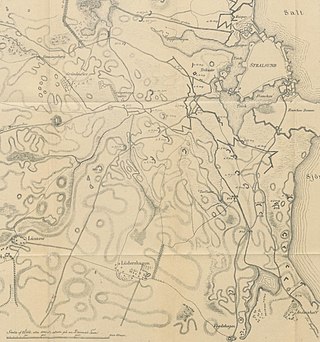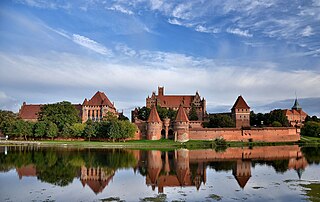
The Great Northern War (1700–1721) was a conflict in which a coalition led by the Tsardom of Russia successfully contested the supremacy of the Swedish Empire in Northern, Central and Eastern Europe. The initial leaders of the anti-Swedish alliance were Peter I of Russia, Frederick IV of Denmark–Norway and Augustus II the Strong of Saxony–Poland–Lithuania. Frederick IV and Augustus II were defeated by Sweden, under Charles XII, and forced out of the alliance in 1700 and 1706 respectively, but rejoined it in 1709 after the defeat of Charles XII at the Battle of Poltava. George I of Great Britain and the Electorate of Hanover joined the coalition in 1714 for Hanover and in 1717 for Britain, and Frederick William I of Brandenburg-Prussia joined it in 1715.

The Battle of Narva on 30 November [O.S. 19 November] 1700 was an early battle in the Great Northern War. A Swedish relief army under Charles XII of Sweden defeated a Russian siege force three to four times its size. Previously, Charles XII had forced Denmark–Norway to sign the Treaty of Travendal. Narva was not followed by further advances of the Swedish army into Russia; instead, Charles XII turned southward to expel August the Strong from Livonia and Poland-Lithuania. Tsar Peter the Great of Russia took Narva in a second battle in 1704.

The Battle of Poltava was the decisive and largest battle of the Great Northern War. The Russian army under the command of Tsar Peter I defeated the Swedish army under the command of Carl Gustaf Rehnskiöld. The battle put an end to the status of the Swedish Empire as a European great power, as well as its eastbound expansion, and marked the beginning of Russian supremacy in eastern Europe.

Prince Ivan Andreyevich Khovansky was a Russian boyar who led the Streltsy during the Moscow Uprising of 1682, alternatively known as the Khovanshchina. His life was dramatized by Modest Mussorgsky in the opera called after the name of the uprising. Khovansky's moniker, Tararui, derives from the old Russian word for "chatterbox".

The Ingrian War was a conflict fought between the Swedish Empire and the Tsardom of Russia which lasted between 1610 and 1617. It can be seen as part of Russia's Time of Troubles and is mainly remembered for the attempt to put a Swedish duke on the Russian throne. It ended with a large Swedish territorial gain in the Treaty of Stolbovo, which laid an important foundation to Sweden's Age of Greatness.

The Livonian War (1558–1583) was fought for control of Old Livonia. The Tsardom of Russia faced a varying coalition of the Dano-Norwegian Realm, the Kingdom of Sweden, and the Union of the Grand Duchy of Lithuania and the Kingdom of Poland.

The Russo-Swedish War of 1656–1658, known as the War of Rupture, was fought by Russia and Sweden as a theater of the Second Northern War. It took place during a pause in the contemporary Russo-Polish War (1654–1667) as a consequence of the Truce of Vilna. Despite initial successes, Tsar Alexis of Russia failed to secure his principal objective—to revise the Treaty of Stolbovo, which had stripped Russia of the Baltic coast at the close of the Ingrian War. The war ended in a Swedish victory.
Prince Ivan Nikitich Khovansky was a Russian boyar and voyevoda, nephew of Ivan Andreyevich Khovansky and cousin of Tararui.

The siege of Riga by the Russian army under Tsar Alexei Mikhailovich was the main event of the Russo-Swedish War. The fortifications of Riga consisted of a wall with ditch and 5 bastions around the old town. In 1652 Swedes had started construction of a new wall with 12 bastions around suburbs, but by 1656 the work had not been completed. The Russian vanguard consisting of the Vladimir v. Vizin reiters, Daniel Krafert infantry and Iunkmann dragoons approached Riga on August 20 and threw back the Swedes under count of Pärnu, Heinrich von Thurn into the city. Von Thurn was either killed, or captured in the action. The Swedes evacuated the suburbs and withdrew to the old town. A few days later, the main army under Tsar Alexei Mikhailovich arrived on the ships on the Duna River, and laid siege to Riga. The Russian army occupied three camps, two on the east bank of the Duna in Riga's suburbs, and a Corps under Ordyn-Nashokin on the west bank of the Duna, opposite the Kobrun entrenchment.

The siege of Narva, also known as the second battle of Narva, was the second Russian siege of Swedish Narva during the Great Northern War from 27 June to 9 August 1704.

The siege of Pskov between 9 August and 27 October 1615 was the final battle of the Ingrian War with which the hostilities ended. Swedish forces under Gustav II Adolf laid siege to Pskov, but were unable to take the city.

The Battle of Gdov in the Russo-Swedish War took place on September 16, 1657 in Gdov. The battle was a clear victory for Prince Ivan Khovansky of the Tsardom of Russia over Swedish Governor-General Count Magnus De la Gardie allowing the Russians to regroup after a brief resurgence of Swedish resistance.

The Great Sortie of Stralsund was fought in the Franco-Swedish War on 1–3 April 1807, in Swedish Pomerania. A French army under Édouard Mortier invaded Swedish Pomerania in early 1807 and initiated a blockade of the Swedish town of Stralsund, to secure the French rear from enemy attacks. After several smaller sorties and skirmishes around Stralsund, Mortier marched part of his army to support the ongoing Siege of Kolberg, leaving only a smaller force under Charles Louis Dieudonné Grandjean to keep the Swedes at check. The Swedish commander Hans Henric von Essen then commenced a great sortie to push the remaining French forces out of Swedish Pomerania. The French fought bravely on 1 April at Lüssow, Lüdershagen and Voigdehagen, but were eventually forced to withdraw; the Swedes captured Greifswald the next day, after a brief confrontation. The last day of fighting occurred at Demmin and Anklam, where the Swedes took many French prisoners of war, resulting in the complete French withdrawal out of Swedish Pomerania—while the Swedes continued their offensive into Prussia. After two weeks Mortier returned and pushed the Swedish forces back into Swedish Pomerania. After an armistice the French forces once again invaded, on 13 July, and laid siege to Stralsund, which they captured on 20 August; all of Swedish Pomerania was captured by 7 September, but the war between Sweden and France continued until January 6, 1810, when the Swedes were finally forced to sign the Treaty of Paris.
The Battle of Rautus kyrka was a failed Russian attempt to stop a Swedish relief force headed for Kexholm during the Russo-Swedish War (1656–1658). The Swedes, led by Christoffer Burmeister successfully repelled the Russian attack and forced them back.

The Assault on Eda sconce was an incident on 11 February 1658, when a Norwegian force under Michael Opitz attacked the Swedish Sconce at Eda. The Norwegians were successful at first, but were later repelled by the Swedish artillery fire, forcing them to withdraw. The fighting lasted for 2 hours.
The siege of Narva was an unsuccessful Russian siege of the Swedish controlled city of Narva during the early stages of the Russo-Swedish War (1590–1595).

The Augdov expedition was a failed Swedish offensive directed at the city of Augdov (Gdov) in 1657 during the Russo-Swedish War (1656–1658).
The Battle of Lava occurred on 11 August, 1657, when a Swedish force, under the command of Gustav Evertsson Horn, attacked a Russian ostrog at Lava. Horn, who had not been notified that Carl Gustaf Wrangel would not be able to support him, was not able to dislodge the Russians.
The Battle of Kattarp was fought on 3 October (O.S.) or 13 October (N.S.) between Danish and Swedish forces in Kattarp, commanded by King Frederick III and Gustaf Otto Stenbock respectively during the Dano-Swedish War of 1657–1658.

The sieges of Marienburg were two separate Russian sieges of Marienburg, the first in August, and the second in November and December, with the first being unsuccessful and the second being successful.














